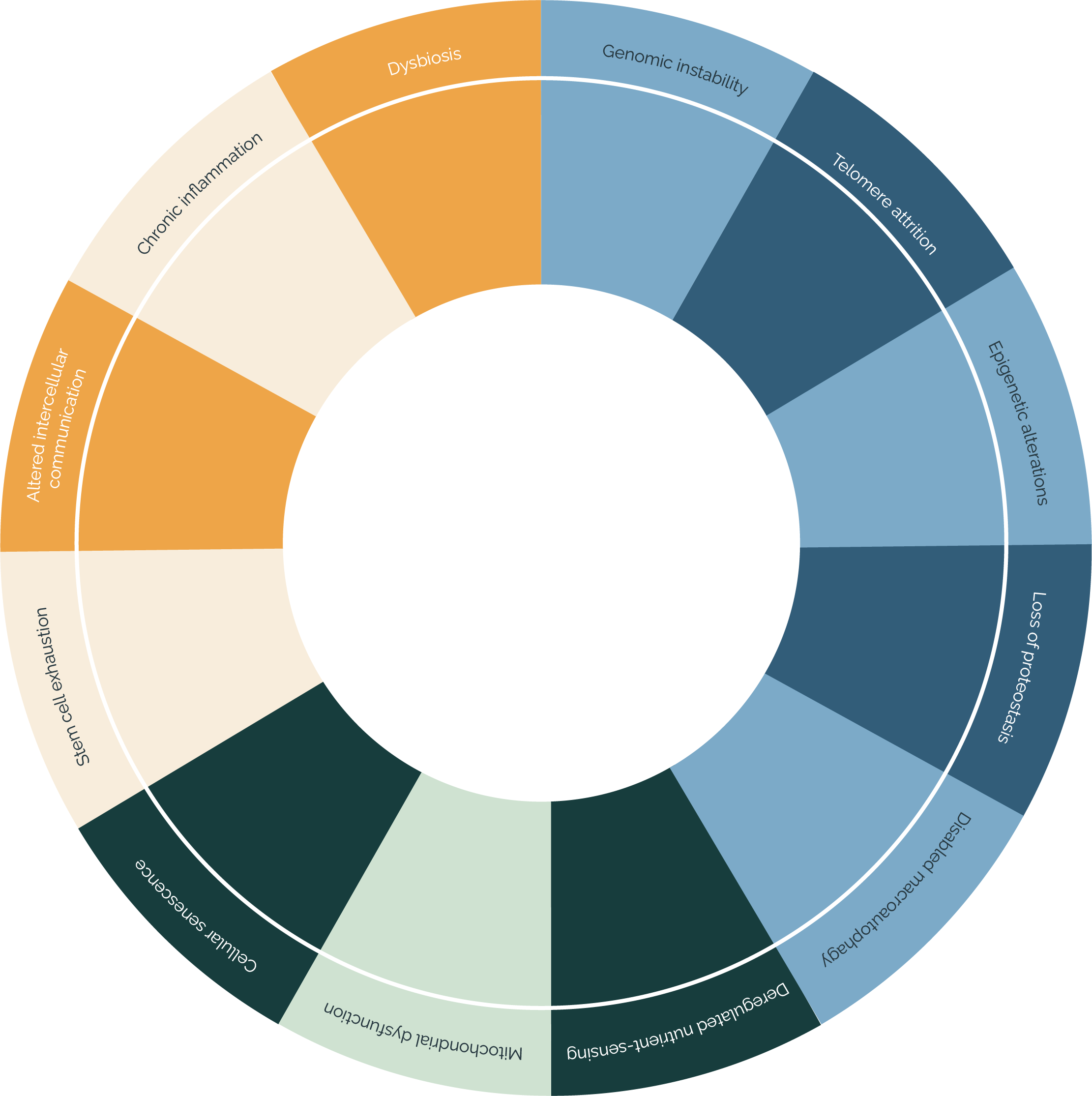Learn about the Hallmarks of Aging
The complex science of aging
Aging processes take place in our cells, organs, and organ systems. These processes are intertwined with each other and occur at different rates. The “Hallmarks of Aging” is a concept in the field of biogerontology (the study of the biology of aging) that refers to a set of interconnected biological and cellular processes or mechanisms that are believed to underlie the aging process (1). These hallmarks are considered fundamental drivers of aging and age-related diseases. The concept was introduced to help researchers better understand the complex and multifaceted nature of aging and to identify potential targets for interventions to promote healthy aging. The field of aging research constantly evolves, and 5 new hallmarks were added to the original 9 hallmarks. It is anticipated that more hallmarks will be added as the research continues to evolve (2).

Genomic instability
Deregulated nutrient sensing
Nutrient sensing is a critical process that allows the body to monitor the availability of nutrients and adjust metabolic and cellular responses accordingly. Dysregulated nutrient sensing refers to a condition in which the body’s normal mechanisms for sensing and responding to nutrients become dysfunctional or imbalanced. Proper nutrient sensing is essential for maintaining overall health and homeostasis.
Altered intercellular communication
Refers to changes in the way cells communicate with each other in an organism. Communication between cells is crucial for coordinating various physiological processes, maintaining homeostasis, and responding to external signals. As organisms age, these communication pathways can undergo changes, leading to increased inflammation, impaired immune responses, and changes in the cellular environment. These disruptions in communication contribute to age-related conditions and can impact overall health and well-being.
Microbiome disturbance
Telomere attrition
Mitochondrial dysfunction
Mitochondria are the cell’s energy-producing organelles. They play a crucial role in various cellular processes, including metabolism and the regulation of cell death. As we get older, the mitochondria can start to weaken, which may lead to inflammation, impaired insulin resistance, heart disease, and Alzheimer’s.
Stem cell exhaustion
Stem cell exhaustion refers to a decline in stem cell numbers and renewal capacity. Stem cells are unique cells in the body with the remarkable ability to develop into various specialized cell types, such as muscle cells, nerve cells, or blood cells. They play a crucial role in tissue repair, regeneration, and maintenance throughout our lives.
Compromised autophagy
Autophagy is a cellular process that involves the breakdown and recycling of damaged or dysfunctional cellular components. It is the cell’s way of cleaning out and recycling its own internal components. Dysfunction in autophagy has been linked to various diseases, including neurodegenerative disorders (i.e., Alzheimer’s disease), cardiovascular diseases, and certain types of cancers.
Altered mechanical properties
Changes in the mechanical properties of cells play a significant role in the aging process. When cells age, their structure shifts, affecting how they move and communicate. That shift contributes to age-related diseases. Exploring how mechanical properties and aging connect could lead to strategies for rejuvenation.
Epigenetic alterations
Cellular senescence
Accumulation of senescent (dysfunctional) cells can disrupt tissue function and promote inflammation. Cellular senescence is a hallmark closely tied to DNA damage and telomere shortening.
Loss of proteostasis
Refers to the loss of the protein equilibrium in the body. Proteins are crucial for our cells to function correctly, and proteostasis ensures they remain in good shape. As we age, our proteostasis system can start to fluctuate. This can lead to problems because proteins might not fold or work as they should. When our proteostasis isn’t working well, it can contribute to age-related diseases like Alzheimer’s or Parkinson’s.
Inflammageing
A term that combines “inflammation” and “aging.” It refers to a chronic, low-level inflammation that tends to increase with age. Inflammageing has been linked to various age-related diseases. Initially grouped under ‘altered intercellular communication,’ inflammation now stands out on its own due to its significant role in aging, interacting with other factors like cellular senescence and the newly suggested gut microbiota.
Splicing dysregulation
Can’t satisfy your curiosity about the hallmarks of aging? Read our article series!
Get the tools to stay healthy longer
There is no universal formula for staying biologically younger. It requires individual solutions.
At NEM, we don’t just measure your biological age. We use it as a tool to gain a deep understanding of your health and your needs. By interpreting clinical findings and biometric data, your personal physician creates a tailored Action Plan with recommendations on nutrition, exercise, sleep, supplements, and lifestyle changes. Through regular check-ups and continuous testing, you build new, sustainable habits that support a longer and healthier life.
References
- López-Otín C, Blasco MA, Rapphöna L, Serrano M, Kroemer G. Kännetecknen för åldrande. Cell. 2013 juni 6; 153(6):1194–217.
- Schmauck-Medina T, Molière A, Lautrup S, Zhang J, Chlopicki S, Madsen HB, et al. Nya kännetecken för åldrandet: en sammanfattning av ett åldrandemöte i Köpenhamn 2022. Åldrande. 2022 29 augusti; 14(16):6829–39.

